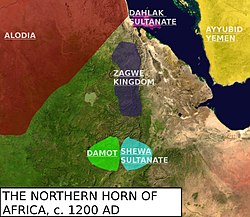
Back Damot padşahlığı Azerbaijani দামোটের রাজ্য Bengali/Bangla Damot Catalan Království Damot Czech Reino de Damot Spanish Royaume de Damot French ממלכת דמות HE Regno di Damot Italian ダモト王国 Japanese दामोत Marathi
Kingdom of Damot | |||||||||
|---|---|---|---|---|---|---|---|---|---|
| c. 13th century–c. 16th century | |||||||||
 The kingdom of Damot and its neighbours circa 1200 AD | |||||||||
| Capital | Maldarede 9°23′N 37°34′E / 9.39°N 37.56°E | ||||||||
| Common languages | Gonga, and other Omotic languages | ||||||||
| Religion | Paganism, Christianity | ||||||||
| Government | Monarchy | ||||||||
| Motalami | |||||||||
| History | |||||||||
• Established | c. 13th century | ||||||||
• Conquered by Ethiopia | c. 1316 | ||||||||
• Disestablished | c. 16th century | ||||||||
| |||||||||
The Kingdom of Damot (Amharic: ዳሞት) was a medieval kingdom in what is now western Ethiopia.[1] The territory was positioned below the Blue Nile.[2] It was a powerful state that forced the Sultanate of Showa (also called Shewa) to pay tributes. It also annihilated the armies of the Zagwe dynasty that were sent to subdue its territory. Damot conquered several Muslim and Christian territories.[3] The Muslim state Showa and the new Christian state under Yekuno Amlak formed an alliance to counter the influence of Damot in the region.[4]
Some academics have claimed that Damot was equivalent to the Kingdom of Wolaita, with the most famous ruler of Damot, Motolomi Sato, coming from the Wolaita Malla dynasty which ruled from the 13th-16th century, before being replaced by the Tigre Malla dynasty amid the Oromo expansion.[5]: 59
- ^ Shinn, David (2013). Historical Dictionary of Ethiopia. Scarecrow Press. p. 111. ISBN 9780810874572.
- ^ Shillington, Kevin (4 July 2013). Encyclopedia of African History 3-Volume Set. Routledge. ISBN 9781135456696.
- ^ Bounga, Ayda (2014). "The kingdom of Damot: An Inquiry into Political and Economic Power in the Horn of Africa (13th c.)". Annales d'Ethiopie. 29: 262. doi:10.3406/ethio.2014.1572.
- ^ Hassen, Mohammed. Oromo of Ethiopia (PDF). University of London. p. 4.
- ^ Aalen, Lovise (2011-06-24). The Politics of Ethnicity in Ethiopia: Actors, Power and Mobilisation under Ethnic Federalism. BRILL. ISBN 978-90-04-20937-4.